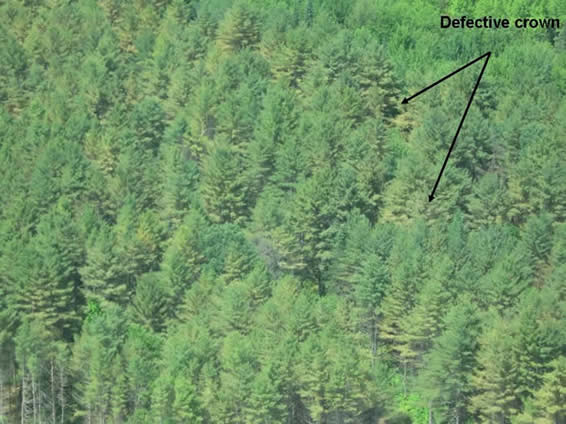DACF Home → Bureaus & Programs → Maine Forest Service →Forest Health & Monitoring → Forest Pest Index →White Pine Needlecasts
White Pine Needlecasts
(Canavirgella banfieldii and Mycosphaerella dearnessii)
In June 2010, the majority of public assistance requests for tree disease concerns were due to the yellowing, browning, and premature needle loss of white pines. The condition was observed throughout the state, but was most severe in western and southern counties. The occurrence of needle diseases and needle browning on white pine was reported from throughout New England.
 Two diseases (caused by fungi) were of particular importance, and trees were affected by either or both. The first is called Canavirgella needle cast (Canavirgella banfieldii); the second is called “brown spot” (Mycosphaerella dearnessii). Significant levels of Canavirgella had been observed since 2006, potentially as a result of the very wet springs and summers we had. The fungi require free moisture to germinate and grow into the needles, and those years had been very wet. The yellowing needles are one-year-old needles. Infection (if it occurs) of the new needles takes place in spring and summer. There are no fungicides recommended for managing either brown spot or Canavirgella, primarily because they have not been a serious problem before.
Two diseases (caused by fungi) were of particular importance, and trees were affected by either or both. The first is called Canavirgella needle cast (Canavirgella banfieldii); the second is called “brown spot” (Mycosphaerella dearnessii). Significant levels of Canavirgella had been observed since 2006, potentially as a result of the very wet springs and summers we had. The fungi require free moisture to germinate and grow into the needles, and those years had been very wet. The yellowing needles are one-year-old needles. Infection (if it occurs) of the new needles takes place in spring and summer. There are no fungicides recommended for managing either brown spot or Canavirgella, primarily because they have not been a serious problem before.
To date, there has been no documented tree mortality from these diseases, but some trees do appear to have very thin crowns. Younger, regenerated trees in the understory are also affected, and may be more at risk of succumbing than the mature overstory trees.
More information about a 2011 regional study of white pine needlecasts can be found here.
MAINE DEPARTMENT OF AGRICULTURE, CONSERVATION AND FORESTRY
Maine Forest Service - Forest Health and Monitoring Division